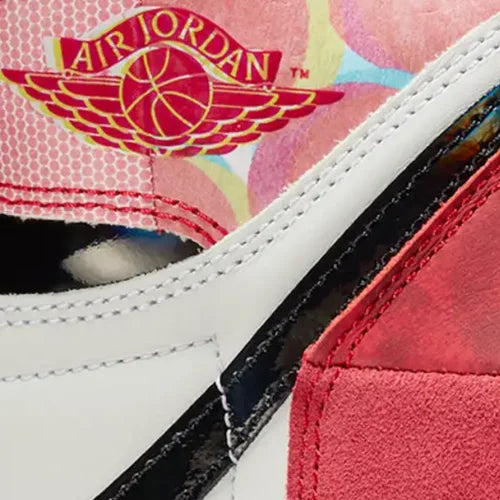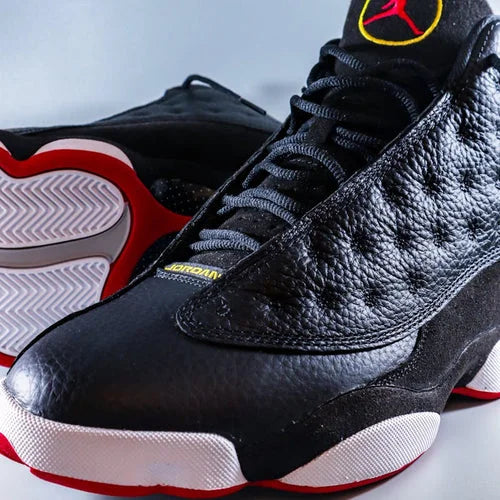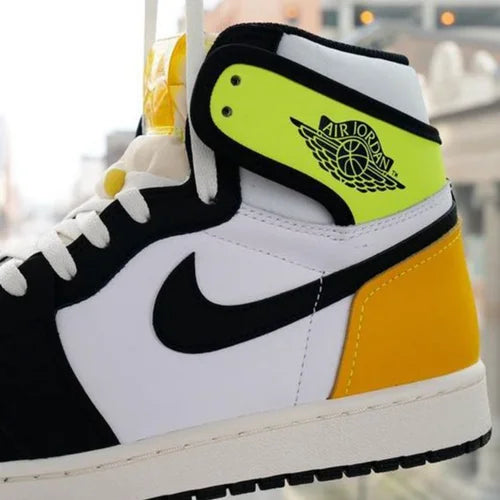How To Spot Fake Air Jordan 13 Flint

Knowing how tricky it can be to legit check Jordan 13 Flint, we decided to write a comprehensive authentication guide for you. This guide is meant to help you quickly verify your sneakers at home, without any additional tools.
However, if you need a professional Jordan 13 Flint authentication, you are in the right place. All you need to do is send us some good quality photos of your pair, and we will provide quick detailed results and a unique authenticity certificate.
Table of Contents
[ open ]Assessing the Overall Shape
For starters, we suggest you pay your attention to the overall shape of the shoe. Right off the bat you can notice a flaw in coloring, although the colors may appear different under various lighting.
The shape of the shoe is also incorrect, and it becomes more obvious when looking at the heel and the toe box areas. The heel of the authentic shoe has a straight line shape, while the fake one is more curved. The toe box, on the other hand, is not curved enough.
Another detail that the Jordan 13 Flint replica got wrong is the white pods on the midsole, which are incorrectly shaped. We also advise you to be wary of any loose threads sticking out, as they definitely raise suspicion about the authenticity of the pair.
Finally, pay attention to the textures. The blue fabric, intertwined with reflective 3M detailing, should have a more dimpled look. The texture of the gray suede should feel very smooth, because the authentic model uses higher quality materials. Not only that, but the stitching of the fake is bigger and looks more obvious.

Examining the Jumpman 23 Hologram
For our second method, let’s look at the Jumpman hologram placed on the ankle.
You can notice that the colors differ, but fear not, because the color of the hologram actually changes depending on the lighting. What you should really pay attention to is the stitching and the design of the hologram.
The stitching of the Jordan 13 Flint replica here is clearly done poorly, some stitches are uneven and look roughly done.
The design on the fake hologram is off-centered so much that the full silhouette of the Jumpman logo and the “23” numbers cannot be fully seen. Not only that, but the “23” is done in a different font, as the letters are slightly thinner.

Inspecting the Toebox Details
The next method of Jordan 13 Flint authentication that we are going to cover today is the toebox method.
On the fake VS real Jordan 13 Flint comparison below you can notice how the authentic shoe is made of higher quality leather, judging by the leather texture. It is very textured and you can see individual lines, which signifies that the sneakers are made from real, excellent leather. The fake one looks too smooth, and may also have an unpleasant factory smell, which the real pair of course should not have.
Next, check the black and white Jordan tag. The size and font of it are wrong. The fake tag is slightly smaller, and the letters are thinner. The stitching is also smaller than needed.
Also Read: How To Spot Fake Jordan 3 Fragment

Analyzing the Throat Jumpman Logo
Coming up next, let’s discuss the Jumpman logo placed on the throat of the shoe.
First of all, the logo on the throat is the wrong color. The authentic has a slightly lighter shade of blue, also called University Blue.
The stitching of the logo should be dense, but not bumpy, and this is where the replica gets it wrong. Due to excessive stitching, the Jumpman silhouette appears to be too thick. Notice how his arms look like tubes, and the head is too big. Not only that, but the fake has a line in the crotch area that is not needed.

Reviewing the Size Tag Accuracy
As for the size tag, we recommend you to focus on the font, as it can instantly give away cheap manufacturing.
The text of the fake tag is obviously thicker, which is especially noticeable on the bottom text. This is due to replicas having poorer quality of printing.
The “LNM” text is also wrong. On the authentic it is thinner, more delicate, and placed further from the edge of the tag.
Finally, notice the white frame around the size tag. In the original it is thicker and made of more dense material, while in the replica it looks cheaply made.

Evaluating the Insole Design
Next on our list is the insole method. The most obvious flaw of this replica is the incorrect colors. However, this replica is one of the poorer quality models, and most of the better quality fakes actually get the colors right.
To be certain about the authenticity, inspect the Jumpman logo, his size and body proportions. Here he appears to be thinner than on the original.
If these methods did not convince you enough and you want to inspect the insole more, just keep reading for more tips.
Also Read: How to Tell If Jordan 12s Are Fake

Checking the Underside of the Insole
Now, let’s turn the insole upside down and move on to the next method.
The first thing to examine here is the font. Clearly, the fake insole has its font much smaller and thicker, which makes it less legible. Not only that, but the “DuraPontex” logo looks misplaced, judging by the distance of the logo from the edge of the insole.
The second problem is that you can actually see the glue pattern on the insole. While even in some authentics it can also be seen, the glue pattern in most of the authentic Jordan pairs is usually diagonal stripes, not horizontal.
Read Next: Fake vs. Real Jordan 11 Bred

Verifying the Footbed Stitching
Moving on, let’s pay attention to the footbed, found under the insole. This is where many replicas have flaws, because the regular buyer rarely checks this area. But we pay attention even to the smallest details, so let’s authenticate this part.
What you should notice here is the stitching pattern. In the fake shoe the stitches overlap each other in some places, creating a cross pattern. It should not be this way, as each stitch should be individual and not overlapping with any other elements.
Secondly, the materials of the footbed are different. You can notice it if you look at the pattern of the footbed. In the original the pattern looks like small dots, while the fake one has a zigzag wave pattern.

Authenticating the Outsole Elements
For our last method today we advise you to carefully inspect the outsole.
In the fake Jordan 13 Flint, the color of the navy carbon fiber shank plate is wrong, and the material is poor quality. It looks glossy, while the authentic one should be matte. The white dot pattern is also bigger than necessary. Some colors like grays and blacks are also too dark.
The next mistake is the circular branding in the middle, specifically its size and color. The size of the fake one is too big, and the color a bit darker. You should also pay attention to the Jumpman logo and notice that its shape is not very distinct, so it looks slightly smudged.

Parting Advice
This brings us to the end of our guide. We sincerely hope this information was useful for you. When checking for authenticity, keep an eye out for these common flaws in fake Jordan 13 Flint sneakers:
- Incorrect overall shape – Bulkier or misshapen heel and toe box.
- Poor quality hologram – Off-centered logo, blurry numbers, uneven stitching.
- Inconsistent toebox design – Smooth leather texture, weak stitching, and misplaced branding.
- Flawed throat Jumpman logo – Thick stitching, incorrect proportions, and wrong color.
- Incorrect size tag font – Thick, misaligned, or fuzzy text.
- Low-quality insole print – Off-centered, faded, or blurry branding.
If you have any doubts about the authenticity of your shoes or any other brand item, feel free to contact our team of experts. We will be glad to help you!















